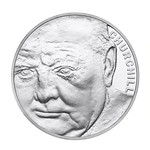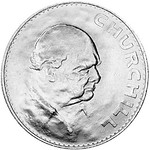
PREV ARTICLE
NEXT ARTICLE
FULL ISSUE
PREV FULL ISSUE
NOTES FROM E-SYLUM READERS: NOVEMBER 23, 2014Collector and Investor Views of the Churchill Crown
Last week David Pickup wrote:
Martin Purdy writes:
Davis of course, was speaking from an investor's point of view. The original Churchill crown is a wonderfully designed and
executed coin. -Editor
To read the earlier E-Sylum article, see:
Blood Swept Lands and Seas of Red
I lived in London in 1997, and the Tower of London was one of my favorite places. The castle, which sits on the banks of the Thames and dates back 1000 years, has played a prominent role in England’s history, including its numismatic history. My daily commute allowed me the option of exiting the Tube one stop early and then walking past the Tower of London to pick up the final leg of my journey a few blocks away. I never tired of the view to my right as I hurried to the next station. While I was in London the dry moat was unutilized and inaccessible, but I do recall that some archeological excavations were underway in part of it. In a letter that I had written to the person in charge of the excavations I suggested that when they were done they should fill the moat with water and stock it with alligators. Artist Paul Cummins obviously found a better use for it. Absolutely. The installation is stunning and can only be fully appreciated in person. I regret I'll only get to experience it
through photos. I'll bet every occupant of the Tower thru its 1,000-year history would be just as entranced by it as today's Londoners. I
agree that it's a shame it hasn't gotten more press in the U.S. I had to learn about it from someone who'd just travelled there.
-Editor
To read the earlier E-Sylum article, see:
E-Sylum 1792
I note that E-Sylum membership has now reached 1792. May I suggest that you freeze membership at that number and accept no additional subscribers? Of course, it would be a shame to limit the growth of The E-Sylum and deny its benefits to others. Perhaps you can come up with another phrase, such as "The E-Sylum now has 1792 subscribers and 100 additional readers" or "The E-Sylum now has 1792 subscribers and 200 additional participants." You might think of something more creative. I knew someone would notice that magic number, a key year in the development of U.S. coinage. Who better than "Mr. 1792"?
But I'll remain uncreative and shoot for 1,800 and beyond. -Editor
To read the earlier E-Sylum article, see:
Query: Roman Proof and Wire Edge Term Origins
Can any of the E-Sylum readers tell me when the term "Roman proof" was first used in numismatic literature, and by whom? Also, who first used the term "wire edge" to describe the thin fin found where the rim and edge meet on some gold coins? "Wire edge" and "Wire rim" have been around for some time, but I don't know where these terms originated.
I'm unfamiliar with the term "Roman proof". Can anyone help? Thanks. -Editor
Wayne Homren, Editor The Numismatic Bibliomania Society is a non-profit organization promoting numismatic literature. See our web site at coinbooks.org. To submit items for publication in The E-Sylum, write to the Editor at this address: whomren@gmail.com To subscribe go to: https://my.binhost.com/lists/listinfo/esylum All Rights Reserved. NBS Home Page Contact the NBS webmaster 
|


